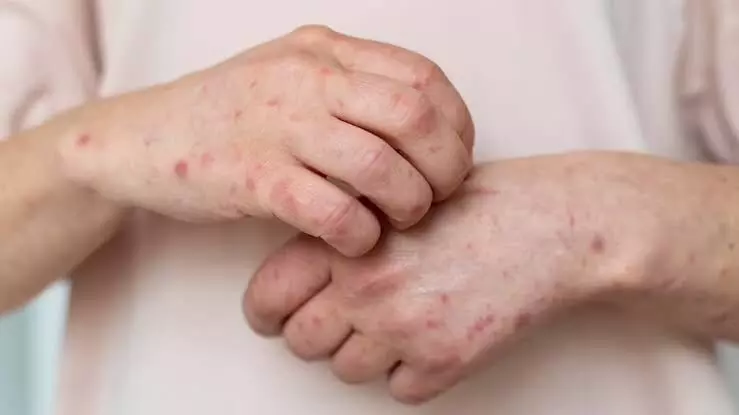Fungal infections spike in monsoon: Wet surfaces perfect environment for growth, spread of fungi
An approach involving early identification, patient education, and complete treatment is crucial
By Newsmeter Network
Representational Image
Hyderabad: The monsoon season brings with it a rise in humidity and moisture retention—the perfect environment for superficial and opportunistic fungal infections.
Areas of the body that are more prone to sweating, such as the underarms, groin and the space between the toes, are particularly susceptible to fungal infections. Another factor contributing to the spread of fungal infections during the monsoon is close contact with water and wet surfaces.
Walking in rainwater, wearing wet clothes or shoes for prolonged periods, and the general dampness in the environment can all contribute to the growth and spread of fungi.
As general physicians, we are often the first point of contact for patients across all age groups presenting with skin, nail, mucosal or even systemic fungal infections. Early recognition and prompt management can prevent chronicity, secondary bacterial infections and transmission within households.
Here are some common fungal infections:
I. Fungal infections in children
1. Tinea Corporis
2. Tinea Capitis
3. Candidal Intertrigo / Diaper Dermatitis
4. Oral Thrush
II. Fungal infections in adolescents and teenagers
1. Tinea Cruris (Jock Itch)
2. Tinea Pedis
3. Tinea Versicolor
III. Fungal infections in adults
1. Tinea Corporis, Cruris, and Pedis
2. Candidal Vulvovaginitis:
i. Presents with Itching and irritation in the vulval area
ii. Thick, white vaginal discharge
iii. Burning sensation or soreness during urination
iv. Redness and swelling of vulva and vagina
3. Intertrigo
4. Onychomycosis: Thickened, discoloured, brittle nails; may coexist with tinea pedis
IV. Fungal infections among elderly
1. Onychomycosis and Tinea Pedis
2. Oral Candidiasis:
i. Common in: Denture users, diabetics, those on inhaled corticosteroids
ii. Presents with White plaques, angular cheilitis
3. Chronic Intertriginous Candidiasis
V. Rare opportunistic infections
In high-risk groups: Immunosuppressed patients such as steroid users, malignancy patients, immunosuppressant drugs for autoimmune conditions or organ, stem cell or bone marrow transplants.
1. Pulmonary Aspergillosis
2. Candidal Urinary Tract Infections
3. Allergic Bronchopulmonary Aspergillosis
4. Pneumocystis Pneumonia
5. Rhinocerebral and Pulmonology Mucormycosis
6. Cryptococcal meningitis
How do they spread?
Common ways to get fungal infections include:
* Damp public spaces, like showers and locker rooms.
* Through a break in your skin or an injury.
* From breathing in fungus from the environment (like soil or dust).
* From taking prolonged over-the-counter antibiotics.
* Direct contact with an infected person
How to prevent infections?
1. Keep Your Skin Dry: Always dry your skin thoroughly after bathing, especially in areas prone to sweating, like the underarms, groin and between the toes. Focus on skin folds where moisture can build up.
2. Wear Breathable Fabrics: Choose loose-fitting cotton clothes that allow your skin to breathe and absorb sweat. Avoid wearing tight, synthetic clothes that keep in moisture.
3. Change Wet Clothes Quickly: If you get wet, change into dry clothes immediately to prevent creating a damp environment where fungi can grow.
4. Maintain Good Hygiene: Bathe regularly and ensure you clean and dry intimate areas well. Always use clean towels and avoid sharing personal belongings.
5. Stay Hydrated: Drinking plenty of water helps maintain overall health, keeps you properly hydrated.
6. Maintain a Balanced Diet: A diet rich in vitamins and minerals supports your immune system and helps your body fight off infections. Include foods like yoghurt, garlic, and leafy greens, which have antifungal properties.
7. Consult a Doctor for Persistent Symptoms: If you notice symptoms of a fungal infection, it’s important to consult a physician for proper diagnosis and treatment.
Fungal infections during the monsoon are ubiquitous, and their burden extends across all age groups — from diaper rashes in infants to chronic onychomycosis in the elderly. An approach involving early identification, patient education, and complete treatment is crucial. Considering underlying comorbidities like diabetes and promoting good hygiene practices remain the cornerstone of management and prevention during the humid months.
The author is a consultant, general physician and diabetologist at Gemcare Kamineni Hospitals, Kurnool.